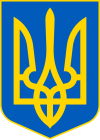| Constitution of Ukraine | |
|---|---|
 | |
| Overview | |
| Original title | Конституція України |
| Jurisdiction | Ukraine |
| Created | 28 June 1996 |
| System | Unitary semi-presidential republic |
| Government structure | |
| Branches | Three |
| Head of state | President |
| Chambers | Unicameral (Verkhovna Rada) |
| Executive | Cabinet of Ministers |
| Judiciary | Supreme Court Constitutional Court and others |
| First legislature | 12 May 1998 |
| Supersedes | 1978 Constitution of the Ukrainian SSR |
| Full text | |
| Footnote | |
| [1] | |
 |
|---|
|
|
The Constitution of Ukraine (Ukrainian: Конституція України, romanized: Konstytutsiia Ukrainy, pronounced [kɔnsteˈtut͡sʲijɐ ʊkrɐˈjine]) is the fundamental law of Ukraine. The constitution was adopted and ratified at the 5th session of the Verkhovna Rada, the parliament of Ukraine, on 28 June 1996.[2] The constitution was passed with 315 ayes out of 450 votes possible (300 ayes minimum).[2] All other laws and other normative legal acts of Ukraine must conform to the constitution. The right to amend the constitution through a special legislative procedure is vested exclusively in the parliament. The only body that may interpret the constitution and determine whether legislation conforms to it is the Constitutional Court of Ukraine. Since 1996, the public holiday Constitution Day is celebrated on 28 June.[3][4]
In 2004, amendments were adopted that significantly changed Ukraine's political system; these changes are sometimes referred to as the 2004 Constitution. In 2010, then-President of Ukraine Viktor Yanukovych reverted these changes on the basis of a ruling made by the Constitutional Court of Ukraine. Following the events of Euromaidan (2013–2014), the 2004 amendments were reinstated.
- ^ "Constitution of Ukraine". rm.coe.int - Council of Europe. 28 June 1996. Retrieved 21 October 2024.
- ^ a b Ukraine celebrating 20th anniversary of Constitution, UNIAN (28 June 2016)
- ^ Yulia Tymoshenko Goes On Trial A Day Before Constitution Day, Eurasia Daily Monitor (30 July 2011)
- ^ 1996: THE YEAR IN REVIEW Archived 3 March 2016 at the Wayback Machine, The Ukrainian Weekly (29 December 1996)